Clinical Psychology:
 Title: PHENOMENOLOGICAL RESEARCH ON NURSES WITH PEDIATRIC CLIENT DIAGNOSED WITH ACUTE LYMPHOBLASTIC LEUKEMIA
Title: PHENOMENOLOGICAL RESEARCH ON NURSES WITH PEDIATRIC CLIENT DIAGNOSED WITH ACUTE LYMPHOBLASTIC LEUKEMIA
Submission code: VP_026
Authors: Elenita M. Tiamzon, Mª Cristina J. Estioco, Jenny R. San Juan, John Mark S. Borbon, Michiko Aboyme, & Vladimir Julius Castillo
Abstract: This phenomenological study investigated, evaluated, and interpreted the nurses’ experiences towards handling pediatric patients who are diagnosed with Acute Lymphoblastic Leukemia (ALL) and how the nurses dealt on difficult situations, tasks and emotions that are within the scope of the study. The main source of data came primarily from the responses out of an interview of a total of 10 Nurses working at WCMC with experience in handling patient diagnosed with ALL. Findings from the study revealed the experiences of the nurses in handling pediatric client diagnosed with Acute Lymphoblastic Leukemia (ALL) in terms of the three categories; difficult situations (experiences), tasks, and emotions. In terms of difficult situations, the strategies that most of the respondents used aside from the traditional way (book-based) of getting their client’s trust and cooperation is by the way of traditional practices based on the previous experience they’ve had upon their exposure to leukemic patients. One of the main benefits of utilizing their traditional ways of practice is the ability to pass on their knowledge onto both the staff and the families. In terms of tasks of the respondents, majority of them facilitate communication toward the family and relatives by means of understanding, asserting, and patience. Families should be encouraged to share their thoughts with them whether it be illness-related problems about the client or non-illness related problems that is occurring within the family. In terms of emotions of the respondents, each of them has their own way of expressing and handling emotions by means of coping mechanisms within the nurse-client relationship including the family. In order to provide effective care, it is important for the nurse to understand and analyze these emotions that come about throughout the diagnosis. Trust and cooperation were established after dealing with patients and family and health education was given to enable patients to handle their difficulty and different situations. Patients were given therapeutic communication that encouraged them to verbalize their feelings clearly and openly understand, accept, and dealt with patience and assertiveness. The nurses were able to assist and encourage the patients and family in the development of their own coping mechanisms to deal with their emotions.
Keywords: Pediatric client, acute lymphoblastic leukemia, difficult situations, tasks, emotions.
File Extension: AVI (.avi)
Title: 40 HEALTHCARE PROFESSIONALS AND PATIENTS ABOUT AN AUTONOMY SUPPORTIVE ENVIRONMENT IN FRENCH GERIATRIC CARE SERVICES: WHAT THEY SAY?
Submission code: VP_040
Authors: Guillaume Souesme, & Claude Ferrand
Abstract: Statement of the Problem: Based on Self-Determination Theory (SDT; Deci & Ryan, 1985), autonomy support appears to be a key factor for patients in geriatric care services (GCS) for the satisfaction of the three basic psychological needs of autonomy, competence, and relatedness (Souesme et al., 2016). Indeed, some researchers highlighted three profiles of older adults: (1) individuals with high need satisfaction (NS) were individuals with lower scores of depressive symptoms (DS) and apathy (A), (2) individuals with low-moderate NS obtained higher scores of DS and A than those of the first profile, and (3) individuals with high-moderate NS had high-moderate scores of DS and A. Moreover, individuals with high score of perceived autonomy support were patients of profile (1). With these knowledges, we wanted to fill the gap because none studies have been conducted with healthcare professionals and patients about “what elements might compose an autonomy-supportive environment?” Indeed, it seems interesting to clarify behaviors underlying an autonomy-supportive motivational style in GCS. Methodology & Theoretical Orientation: Three hospitals accepted to participate to the study. Seven focus groups (four with healthcare professionals and three with patients) have been conducted with a semi-structured guide (Patton, 2002) to explore the point of view of healthcare professionals and patients about an autonomy-supportive environment. A total of forty-four (n=44) individuals, including twenty-six (n=26) professionals representing all professions working on GCS and eighteen (n=18) patients were recruited. All focus group were transcribed verbatim and content qualitative analyses were performed using a software analysis (NVivo 10-QSR International) and a manual content analysis approach. Findings: (A) Our results based on queries for text analysis highlighted three categories defining the notion of autonomy support in health context for professionals. These categories point out well the importance of the social link between medical staff and patients through the “promotion of progress”, the importance of “establish a relationship of trust”, and the necessity to “encourage them (patients) to express themselves”. (B) Results from patients focus group are still in progress. (C) Expected results should highlight common points and differences outlook between healthcare professionals and patients. This will allow us to make recommendations and propose training sessions for professionals to adopt an autonomy-supportive motivational style.
Keywords: Self-determination theory, autonomy support, geriatric care services, older people, qualitative analysis.
File Extension: Windows Media Audio/Video file (.wmv)
 Title: SELF-ESTEEM AND DEPRESSION IN ADOLESCENTS WHO CONSUME PSYCHOACTIVE SUBSTANCES
Title: SELF-ESTEEM AND DEPRESSION IN ADOLESCENTS WHO CONSUME PSYCHOACTIVE SUBSTANCES
Submission code: P_085
Authors: Ibtissam Cherkaoui El Malki, Imad Echerbaoui, Khaoula Mammad, Youssef El Madhi, & Ahmed O. T. Ahami
Abstract: Adolescence is considered a risk period for the use of psychoactive substances (PAS). While adolescents face stressful life events, for which they have only partially the social resources and the cognitive means to cope with them. It is recognized that low self-esteem is one of the symptoms of depression in adolescents.
The study is of the transversal type with descriptive and analytical aims. Including 714 young students (high school students) aged 15 to 21 years. The instrument used is an anonymous self-questionnaire centered on the uses, attitudes and opinions relating to psychoactive substances, Self-questionnaire for adolescents: ADRS (Adolescent Depression Rating Scale) patient version in 10 items, and Rosenberg’s Self-esteem Scale.
Our result shows that the presence of depressive symptomatology in the adolescent population studied, but with a significant difference between consumers and non-consumers (t = 4,701, p <0.001). Thus, the majority of teenagers consuming of PAS exhibited a depressive tendency 66.86%, Also a deficit of self-esteem in both adolescent populations. However, it is more expressed among consumers (t = -7.191, p <0.001). Thus, 57.99% of consumers have low self-esteem and 26.04% have very low self-esteem. While among the non-consumer population, 50.28% have low self-esteem and 9.72% have very low self-esteem.
Keywords: Psychoactive substances, self-esteem, depression, adolescents, Morocco.
File Extension: MP4 (.mp4)
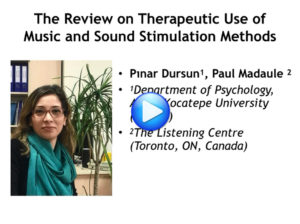 Title: THE REVIEW ON THERAPEUTIC USE OF MUSIC AND SOUND STIMULATION METHODS
Title: THE REVIEW ON THERAPEUTIC USE OF MUSIC AND SOUND STIMULATION METHODS
Submission code: VP_135
Authors: Pınar Dursun, & Paul Madaule
Abstract: Music heals (Habibi & Damasio, 2014). Since ancient times, healing through music which evokes and regulates emotions from agony to euphoria has been accepted as a remedy method for centuries. For instance, in Anatolia, Greeks used to place an ill person into the middle of the amphitheater and exposed specific sounds and voices to him for recovery (Thompson & Andrews, 2000). Similarly, particularly during Ottoman Empire, having been accepted of the notion that “music is medicine” led different timbres and notes of Classical Turkish Music to be evolved and used for healing in various clinical conditions especially for psychiatric patients at hospitals called “Şifahane” (Gençel, 2006). Accordingly, many people today still tend to use music for feeling better, managing their emotions, concentrating more, coordinating their movements. Especially in the last 20 years, music pyschology literature has shown that music processing even passive music listening affects the neurochemistry of the brain structures in both hemispheres (e.g., Bidelman, Krishnan, & Gandour, 2011; Blood & Zatorre, 2001; Brown, Martinez, & Parsons, 2004; Menon & Levitin, 2005; Peretz, & Zatorre, 2005). Hence, there has been a growing interest in the world related to music-making and music-listening therapies including sound therapies particulary used for various developmental difficulties (e.g., Esteki & Soltani, 2015; Molnar-Szakacs & Heaton, 2012; Neysmith-Roy, 2001) since the efficacy of auditory processing which plays a fundamental role in many sensory, perceptual, and even higher-order cognitive functions empirically has been proved (see Kraus & Banai, 2007). Sound therapies such as audio-psycho-phonological methods (Tomatis, 1996) promote the training of listening perception instead of passive hearing that increase learning, listening and language skills. Also, keeping a steady beat can help individuals to develop a sense of security and internal stability feeling which bring order and harmony. Hence, the present paper aims to review on the roots of therapeutic use of music, the impacts of music on the nervous system, and lastly focus on the description and the implications of the audio-psycho-phonological methods with current literature findings.
Keywords: Music therapy, sound therapy, auditory stimulation, neuro-developmental disorders.
File Extension: QuickTime Movie (.mov)
 Title: THE RELATIONSHIP BETWEEN ADULT ATTENTION DEFICIT HYPERACTIVITY DISORDER AND MARITAL ADJUSTMENT
Title: THE RELATIONSHIP BETWEEN ADULT ATTENTION DEFICIT HYPERACTIVITY DISORDER AND MARITAL ADJUSTMENT
Submission code: VP_182
Authors: Cemile Esinc Arz, Ipek Guzide Pur-Karabulut, & Elcin Sakmar-Balkan
Abstract: The main aim of the current study is to examine the relationship between attention deficit hyperactivity disorder (ADHD) in adulthood and marital adjustment. The study involved 301 participants (164 women, 137 men) who had been married once, who had been married for at least a year, and who had been educated to a High School level or higher. A demographic information form, an Adult ADHD Self-Report Scale, and a Dyadic Adjustment Scale were administered. Before the research question was tested, a series of analysis of variance tests (ANOVA) and t-tests for independent groups in the analyzes were performed to investigate and determine the demographical information of participants including their gender, employment status, psychological and/or psychiatric support status, and the number of children. The results showed that participants who had two or more children not only reported lower ADHD scores but also lower marital adjustment levels compared to participants who had either one child or no children. Moreover, participants who had received or who were receiving psychological or/and psychiatric support at the time of the study reported higher ADHD levels and lower marital adjustment levels compared to participants who received no support. Before the research question was tested, correlations were also calculated among participants’ demographic information including their age, duration of their marriage, adulthood ADHD, and marital adjustment. The results indicated that duration of marriage was significantly and negatively correlated with both adulthood ADHD and marital adjustment; thus, the duration of marriage resulted in lower ADHD scores and marital adjustment scores. To test the main aim of the study, hierarchical regression analysis was conducted using marital adjustment as the dependent variable. Independent variables were included into the equation according to two steps: first involving number of children, receiving psychological and/or psychiatric support, and duration of marriage; second, by including ADHD scores into the equation. The results demonstrated that, after controlling for first step variables, adulthood ADHD was significantly associated with marital adjustment. In other words, higher ADHD scores were significantly associated with lower marital adjustment levels. These findings are parallel to those in existing and related literature. The results of this study are discussed within the framework of related literature and suggestions made accordingly.
Keywords: Marital adjustment, adulthood attention deficit and hyperactivity disorder.
File Extension: QuickTime Movie (.mov)
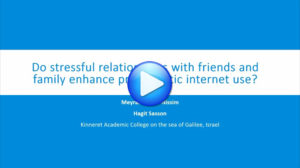 Title: DO STRESSFUL RELATIONSHIPS WITH FRIENDS AND FAMILY ENHANCE PROBLEMATIC INTERNET USE?
Title: DO STRESSFUL RELATIONSHIPS WITH FRIENDS AND FAMILY ENHANCE PROBLEMATIC INTERNET USE?
Submission code: VP_191
Authors: Meyran Boniel-Nissim, & Hagit Sasson
Abstract: During adolescence, adolescents move away from their parents in order to establish their place in society. Therefore, there are two arenas that have a significant impact on adolescents; the family and the social one. The intensive use of adolescents on the internet leads to concern about Problematic Internet Use (PIU). Therefore, the goal of this study was to examine if stressful environments such as being a victim to bullying and/or cyberbullying, and poor relationships with parents could be linked directly and indirectly to PIU. Data was collected from a representative sample of 1,000 adolescents aged 12-17. Measures included demographics, short problematic internet use test, relationships with parents’ questionnaire, cyberbullying scale and separately traditional bullying test. Results revealed that both poor parent-child communication and being a cyberbullying victim were related to PIU. Correspondingly, Poor parent-child communication had indirect effect on PIU through bullying and/or cyberbullying victimization. Conversely, both positive mother-child communication and positive father-child communication had indirect effect on PIU through bullying or cyberbullying victimization, implying that good communication with parents actually can assist reducing victimization to bullying and PIU behavior. Limitations, conclusions, and suggestions for further research are discussed.
Keywords: Problematic Internet Use (PIU), relationship with parents, bullying, cyberbullying, path analysis modeling.
File Extension: MP4 (.mp4)
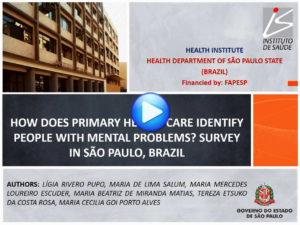 Title: HOW DOES PRIMARY HEALTH CARE IDENTIFY PEOPLE WITH MENTAL PROBLEMS? SURVEY IN SÃO PAULO, BRAZIL
Title: HOW DOES PRIMARY HEALTH CARE IDENTIFY PEOPLE WITH MENTAL PROBLEMS? SURVEY IN SÃO PAULO, BRAZIL
Submission code: VP_212
Authors: Ligia Rivero Pupo, Maria de Lima Salum e Morais, Maria Mercedes Loureiro Escuder, Maria Beatriz de Miranda Matias, Tereza Etsuko da Costa Rosa, & Maria Cecília Goi Porto Alves
Abstract: Introduction: Since 2001, Brazilian Mental Health Policy has structured a new model of care: integral, horizontal, multiprofessional, community based, and intersectoral, focused on needs and rights of service users. Even though such a policy has considered the role of Primary Care as strategic in promotion, prevention, diagnosis, treatment and coordination of care, there is still insufficient knowledge about the care offered to people with mental suffering in Brazilian primary health care services. The São Paulo State Department of Health is conducting a research to identify the characteristics of mental health care offered in their primary care services. This paper, which integrates the quoted research, intends to present some preliminary results regarding the way primary care units identifies mental health needs. Method: The survey involves a telephone inquiry into 1000 primary care health units of São Paulo state, in a stratified simple random sample. Until now, 209 health units responded to the questionnaire elaborated by the researchers’ team. Results: Descriptive analysis of preliminary data indicates that mental health problems are identified with high frequency in primary care services (70% of the units reported that this kind of demand appear daily or weekly), and, in the last three months, 81% of the units stated that they had received some mental health claim. However, one of the most frequent ways of identifying mental suffering claims was the patient’s request for exchange of medical prescriptions (60.3%), related to treatments already in progress. The other two most frequent forms of problem identification were complaints made by the service users themselves (42.5%) and by their relatives (39.3%). Discussion: The data indicate that primary care is a strategic space for the identification of mental health problems, since it is frequent the arrival of demands of this nature. However, these services have a less active role in the search for people with mental suffering, since they depend mainly on the explicit demand made by users and their families. The exchange of medical prescriptions, which the participants cited as the most frequent form of identification of mental health problems in the services, can indicate both a passive role of the unit and a lack of evaluation and of follow-up of already ongoing treatments. Conclusion: There is need for greater participation and involvement of primary care services in active search, and in follow-up of mental health cases.
Keywords: Mental health, primary health care, health services, screening, survey.
File Extension: QuickTime Movie (.mov)
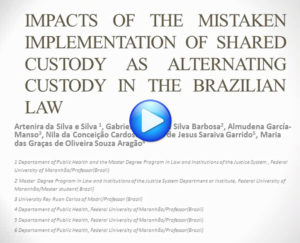 Title: IMPACTS OF THE MISTAKEN IMPLEMENTATION OF SHARED CUSTODY AS ALTERNATING CUSTODY IN THE BRAZILIAN LAW
Title: IMPACTS OF THE MISTAKEN IMPLEMENTATION OF SHARED CUSTODY AS ALTERNATING CUSTODY IN THE BRAZILIAN LAW
Submission code: VP_251
Authors: Artenira da Silva e Silva, Gabriella Sousa da Silva Barbosa, Almudena García-Manso, Nila da Conceição Cardoso, Klitia de Jesus Saraiva Garrido, & Maria das Graças de Oliveira Souza Aragão
Abstract: In Brazil the Law n. 11.698/2008, which modifies the articles 1.583 e 1.584 of the Civil Code, introduces the modality of shared custody in the Brazilian legal system. This type of children’s and teenagers´ custody is characterized not by merely splitting the child in half making them share equal amount of time with both parents, but it actually proposed the sharing of all responsibilities considering children and teenagers, including their educational and health care, for example, allowing both parents to make decisions considering their children’s lives. The law considered in this article transforms the modality of shared custody in a priority in custody judgements in Brazil, considering that, if carefully applied it can be proven to be a less traumatic kind of custody option for children and youngsters. However, the lack of knowledge about the specificities of shared custody is making Brazilian judges implement their decisions prioritizing the modality of alternate custody, mistakenly labelling it as shared custody. In alternate custody the children are split in half and spend equal amount of time with both parents without taking into consideration their age or their wills, thoughts and feelings. It is also important to highlight that it is an exception in Brazil for Family Judges to consider important to hear and to listen to children and teenagers personally before deciding about their custody. Considering the mistaken implementation of these two types of custody by Brazilian judges, this study aims to analyze the psychological social and psychological impacts of the so called alternate custody in the youngers. For this purpose, the methodological procedures used were the bibliographic and documentary researches as well as the application of 38 interviews to youngsters, from 3 to 13 years of age, that are experiencing alternate custody mistakenly labelled as shared custody. The results lead us to conclude that the lack of technical knowledge considering the two kinds of custody as well as the lack of basic knowledge about the psychological and social development of youngsters usually presented by Brazilian judges have negative impacts on the development of the children and teenagers, who feel the adult judges ignore their autonomy when deciding about their custodies.
Keywords: Children and teenagers, Brazilian family law, shared custody, alternate custody, youngsters’ autonomy.
File Extension: Windows Media Audio/Video file (.wmv)
Educational Psychology:
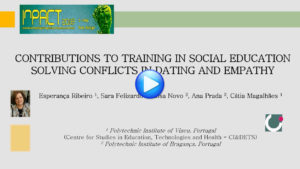 Title: CONTRIBUTIONS TO TRAINING IN SOCIAL EDUCATION: SOLVING CONFLICTS IN DATING AND EMPATHY
Title: CONTRIBUTIONS TO TRAINING IN SOCIAL EDUCATION: SOLVING CONFLICTS IN DATING AND EMPATHY
Submission code: VP_186
Authors: Esperança Ribeiro, Sara Felizardo, Rosa Novo, Ana Prada, & Cátia Magalhães
Abstract: The Social Educator works with very diverse populations for the promotion of well-being and autonomy. In this sense, it is important to understand to what extent higher education students in this area present perceptions regarding the use of conflict resolution strategies (abusive and not abusive in dating) and empathy that can be mobilized in the future exercise of the profession. Hence, the study aims to know the relation between the perceptions of conflict resolution and empathy strategies; and to what extent the influence of sociodemographic variables (gender and age) and degree year. In this way, we seek to foresee how training can contribute to enhance the use of positive strategies for conflict resolution and the improvement of empathic perceptions. A total of 242 students from two Polytechnic Higher Education Institutions participated. This is a non-experimental and cross-sectional study. The instruments used were the Conflict in Adolescent Dating Relationships Inventory – CADRI – developed by Wolfe, Scott, Reitzel-Jaffe, Wekerle, Grasley e Straatman (2001), validated for the Portuguese population by Saavedra, Machado, Martins, e Vieira (2011) and the Interpersonal Reactivity Index (IRI, Davis, 1980, 1983), in the Portuguese version (Limpo, Alves, & Castro, 2010). In the results, we highlight in the CADRI, statistically significant differences; i) by gender, in the abusive strategies of conflict resolution (own behavior – perceptions of sexual violence and behavior of the other – perceptions of physical violence), and non-abusive conflict resolution strategies (behavior of the other); ii) by age (age group) in abusive conflict resolution strategies, behavior of the other-perceptions of physical violence. In IRI, there were statistically significant differences in the subscale of the empathic perspective; in the global scale of empathy (according to gender and degree year), as well as in the empathic concern subscale (according to the degree year). Positive and significant correlations are also found in some of the conflict resolution strategies identified from the CADRI and one of the IRI subscales and dimension, as well as in the global scale. Based on the results, strategies that could be developed in the context of training were thought, with a view to enhancing improvements with impact on the personal and social development of trainees.
Keywords: Social education, empathy, dating violence, conflict behaviors, higher education quality.
File Extension: Windows Media Audio/Video file (.wmv)
 Title: APPLICATION OF TWO APPROACHES: ABA & TEACCH WITH AUTISTIC CHILDREN IN MOROCCO
Title: APPLICATION OF TWO APPROACHES: ABA & TEACCH WITH AUTISTIC CHILDREN IN MOROCCO
Submission code: VP_070
Authors: Khaoula Mammad, Ahmed Ahami, Fatima-zehra Azzaoui, Fatima-zahera Lamrabat, & Samira Boulbaroud
Abstract: Treatment and Education of Autistic and related Communication-handicapped Children (TEACCH) is a less known approach in Morocco. On the other hand, Applied Behavioral Analysis (ABA) used in some isolated cases or in some institutions but without rigorous methodological supervision. The objective of this present work is to establish a strong and adequate educational program for children with autism in Morocco using a method inspired by two different approaches ABA and TEACCH.
The research conducted in a period of one year pre-school. Ten students participated in the research, diagnosed with autism by health professionals (child-psychiatrist neuropsychologist and child-psychologist), participated in the research. At the beginning of the project the group included three girls and seven boys, all aged between 5 and 15 years. Divided into three groups: group 1 where educators are trained in ABA and TEACCH methods and parents participate in the program; group 2 where the educators who participated are also trained, but without parental involvement; and finally group 3: untrained teachers and parents who did not participate in the program. Subsequently, we carried out the first evaluation with valid and complementary tools: PEP3 and CARS, in order to establish an individual educational program (IEP) based on the TEACCH and ABA approach. The results are presented as scattergrams with symbols representing individual data points and the horizontal lines representing the mean for each group. Showed a marked improvement in the cognitive, mental and behavioral skills of autistics. A variance in the mental development of these children in descending order were noted: Group1> Group2> Group3 and it has been found that the youngest children have a greater variance in mental development than older children. It deduced that a high efficiency by the child depends on the participation and the active accompaniment of the parents and especially of the specific training in (TEACCH, ABA) for the educators. Moreover, that age can influence learning flexibility, not to mention the influence of the type of autism and IQ of each child.
Keywords: ABA, TEACCH, autistic children, educators, parents.
File Extension: MP4 (.mp4)
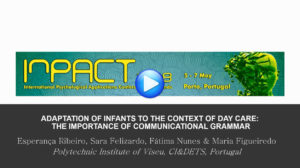 Title: ADAPTATION OF INFANTS TO THE CONTEXT OF DAY CARE: THE IMPORTANCE OF COMMUNICATIONAL GRAMMAR
Title: ADAPTATION OF INFANTS TO THE CONTEXT OF DAY CARE: THE IMPORTANCE OF COMMUNICATIONAL GRAMMAR
Submission code: VP_187
Authors: Esperança Ribeiro, Sara Felizardo, Fátima Nunes, & Maria Figueiredo
Abstract: Day care has a socio-educational nature that should be provided to children as it leads to their overall development and well-being. Enrolment of an infant in this context provides access to situations which differ from those within the family setting. This calls on resources of adaptation on the part of small children, families and professionals. In the nursery, the infant’s day is organized around educational experiences and permanent care that are unique moments to promote didactic interactions and diversified learning. The aim of this research is to identify the strategies and procedures used in the context of the nursery to promote infants’ adaptation and well-being. Interactions between infants (aged 6 to 11 months) and two professionals (at reception, departure and during routine care and education), as well as with family members (upon arrival at the nursery and on returning home), were observed. The professionals were also inquired regarding the strategies used for infants’ adaptation in this context with a view to promoting their well-being. It is a qualitative and exploratory study with recourse to direct observation and semi-structured interview. The strategies used to promote adaptation which emerged from the observations made were triangulated with the results of the interviews. The following results as regards valued strategies have been highlighted: emotional literacy (the professional’s adaptation of responses to the infant’s individuality, the professional’s socio-affective skills); communication with the family (the exchange of information, harmony of procedures, transactional objects) and type of communication (verbal and nonverbal). The results show the importance of using a communicational grammar to safeguard the infant’s adaptation process to a new socio-educational context nature, consequently helping to promote well-being.
Keywords: Day care, infants, adaptation strategies, communication.
File Extension: Windows Media Audio/Video file (.wmv)
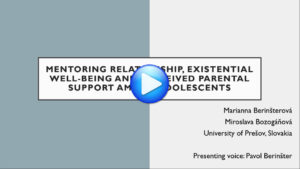 Title: MENTORING RELATIONSHIP, EXISTENTIAL WELL-BEING AND PERCEIVED PARENTAL SUPPORT AMONG ADOLESCENTS
Title: MENTORING RELATIONSHIP, EXISTENTIAL WELL-BEING AND PERCEIVED PARENTAL SUPPORT AMONG ADOLESCENTS
Submission code: VP_183
Authors: Marianna Berinšterová, & Miroslava Bozogáňová
Abstract: The aim of this contribution was to explore an association between a mentoring relationship and selected internal (existential well-being) and external (perceived parental support) variables among middle and late adolescents, controlling for age and gender.
177 students (53% of girls; Mage=16.92, SD=1.69) of 2 high schools from eastern Slovakia participated in the research. Subscale of the existential well-being from the Expressions of spirituality inventory (MacDonald, 2000) was used. Parental support was measured by the Resilience and youth development module questionnaire (Constantine, Benard, Diaz, 1999). Single items were used for the measuring of age, gender and the existence of the mentoring relationship. Logistic regression was used for the data analysis. An interactional effect of the age and the independent variables was also verified.
The first model was significant (Χ2=29.3; df=4; p˂0.001) and explored between 16.7 and 22.5 % of the variance of the dependent variable. The perceived parental support, the existential well-being and the age of adolescents in the sample were significantly associated to the mentor relationship. Gender was not significantly associated to the mentoring relationship.
Interactions of existential well-being, perceived parental support and age were added to the second model. The model was significant (Χ2=40.57; df=6; p˂0.001) and explored between 22.4 and 30.1 % variance of the dependent variable. Older adolescents who reported higher level of the parental support and younger adolescents with higher level of the existential well-being were more likely to have the mentoring relationship. Gender was not associated to the dependent variable.
The results support the knowledge about the positive impact of mentoring on family relationships and existential well-being of adolescents. Benefits of the mentoring relationship can be different considering the age of the adolescents. Formation and realization of mentoring programs should be taking into account developmental specifics of adolescence.
Keywords: Mentoring relationship, existential well-being, perceived parental support.
File Extension: Windows Media Audio/Video file (.wmv)
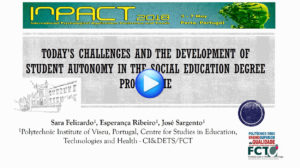 Title: TODAY’S CHALLENGES AND DEVELOPMENT OF STUDENT AUTONOMY IN THE SOCIAL EDUCATION DEGREE PROGRAMME
Title: TODAY’S CHALLENGES AND DEVELOPMENT OF STUDENT AUTONOMY IN THE SOCIAL EDUCATION DEGREE PROGRAMME
Submission code: VP_229
Authors: Sara Felizardo, Esperança Ribeiro, & José Sargento
Abstract: The challenges of our time, in particular the social changes and the proliferation of problems of more highly fragile groups and social exclusion, indicate a need for professionals in the field of pedagogy and education social. The social educator is a mediator of the relations and inclusion of people and groups in their life contexts. This line of research raises the need to reflect on their skills profile, along the lines referred to by AIEJI (2005), who considers the relational and personal skills of the social educator, fundamental tools in social educational work to implement responses and strategies that foster human development. In this context, it is necessary to understand the changes and the processes involved in social education students’ psychosocial development as a result of their experiences in higher education, and thus tailor educational programmes to optimize student development. This study is part of a broader line of research on the students’ process of maturing, in order to promote changes in the curriculum and teaching methods in the degree in Social Education at Viseu School of Education, in the Polytechnic Institute of Viseu, Portugal. The general aim was to analyse the autonomy (and dimensions) of the social education students, finding the extent to which these very depending on the following variables: year of the course, participation in extracurricular activities and investment in academic activities, with the further aim of designing action strategies which promote autonomy. It is a non-experimental, cross-sectional study with a non-probabilistic, convenience sample of 127 students from all three years of the course. The results show significant differences in the overall results in terms of autonomy as well as for the subscales Mobility, Time Management and Money Management, among the students in the 1st and the students in the 2nd and 3rd years, reflecting improvements in autonomy throughout the course. We also found significant differences in the overall values of autonomy and most of the subscales, due to the perception of investing in academic activities and the perception of participating in extracurricular activities. Reflecting on the results led us to design intervention strategies to promote student autonomy.
Keywords: Autonomy, students, social education, higher education.
File Extension: Windows Media Audio/Video file (.wmv)
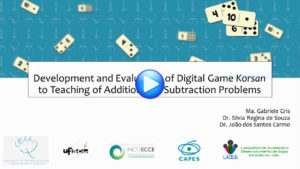 Title: DEVELOPMENT AND EVALUATION OF DIGITAL GAME KORSAN TO TEACHING OF ADDITION AND SUBTRACTION PROBLEMS
Title: DEVELOPMENT AND EVALUATION OF DIGITAL GAME KORSAN TO TEACHING OF ADDITION AND SUBTRACTION PROBLEMS
Submission code: VP_245
Authors: Gabriele Gris, Silvia Regina de Souza, & João dos Santos Carmo
Abstract: This study aims to present the development and evaluation of the educational game Korsan, an adapted domino game with a pirate story, based on the model of network relationships to teaching addition and subtraction problems. To this end, a paper prototype and a digital prototype of the game were assessed, exploring aspects which affect the learning, engagement, and the usability. A six years old boy served as participant of the assessment of the paper prototype. It was taught and test, through the game, conditional relations between numerals, set of dots and addition and subtraction problems with digits and in the form of balance with the unknown in positions a (?+1=2), b (1+?=2) e c (1+1=?). Although the participant had a good performance before the intervention, it was observed an enhanced performance after the sessions with the game. It was observed the maintenance of engagement on the game, but it was also observed the need of adjustments to improve usability for the digital version of the game, especially in game mechanics due to the configuration of domino pieces. For the assessment of first digital version of the game prototype, the adjustments on game mechanics were made. Four children with 7 years old served as participants. The teaching and tests were similar to paper prototype evaluation, but in this phase, only addition problems were taught. It was found a better performance in problem-solving tasks for all participants in all types of problem presentation and unknown position. The results also indicate that the game proved to be adequate to teach solving addition problems and presented adequate usability. It is suggested that including plot and aesthetic elements in future versions of the game can increase player engagement during the game. It should be noted that the participants of both evaluations already identify numerals and sets of dots until ten. For the third development phase of the game will be planned learning conditions to teach mathematics prerequisites in order to facilitate the teaching of children with difficulties and also to assess the role of the prerequisites on arithmetic learning.
Keywords: Mathematics teaching, numerical relations network, elementary school students, educational games, game design.
File Extension: MP4 (.mp4)
 Title: THE NEEDS AND INVOLVEMENT OF SIBLINGS OF CHILDREN WITH AUTISM: CONTRIBUTIONS TO SOCIO-EDUCATIONAL INTERVENTION
Title: THE NEEDS AND INVOLVEMENT OF SIBLINGS OF CHILDREN WITH AUTISM: CONTRIBUTIONS TO SOCIO-EDUCATIONAL INTERVENTION
Submission code: VP_230
Authors: Sara Felizardo, Inês Santos, & Esperança Ribeiro
Abstract: The diagnosis of Autism Spectrum Disorder (PEA) in a child causes profound changes in the dynamics and functioning of the family system, due to difficulties and increased needs of parents / caregivers and siblings. In this context, the fraternal subsystem plays an important role because it constitutes a source of informal social support par excellence, with strong implications on the well-being and the personal functioning of the child or young person with autism (Felizardo, 2016). Considering the relevance of the support of siblings of children and adolescents with autism, the present descriptive and exploratory study aims to understand their needs and involvement. We defined as objectives: i) to know the support network of parents and siblings of children with autism; ii) understand the perceptions of parents and siblings of children with autism about the needs and involvement of siblings, in the areas of awareness, feelings, fun, help and advocacy. The sample is of convenience, and 40 participants (30 siblings and 10 parents of children with PEA) were enrolled in the study. The instruments of data collection were a sociodemographic questionnaire, the Portuguese version of the Siblings Needs and Involvement Profile (Fish and collaborators, 1995), of Reis, Espe-Sherwindt and Serrano (2010) and a semi-structured interview with parents / caregivers. The results show that there is congruence between parent / caregiver and sibling reports, particularly in the areas of awareness / knowledge about autism, feelings, fun and help. In view of the results, the need to intervene intentionally with the siblings of children / young people with autism is reinforced, developing socio-educational actions that promote their involvement and provide support to their needs.
Keywords: Autism, siblings, needs, involvement, socio-educational intervention.
File Extension: Windows Media Audio/Video file (.wmv)
Social Psychology:
 Title: TRUST IN COMPUTER-SUPPORTED CRISIS MANAGEMENT COMMUNICATION: TOWARD A NEW MODEL
Title: TRUST IN COMPUTER-SUPPORTED CRISIS MANAGEMENT COMMUNICATION: TOWARD A NEW MODEL
Submission code: VP_126
Authors: Béatrice Linot, Jérôme Dinet, François Charoy, & Valerie L. Shalin
Abstract: This paper presents a new model, Computer-supported Crisis Management Communication (3C) to capture communication during crisis management when communication is mediated by computational tools. Different services (e.g., police, army, hospital, fire service) support crisis management with different responsibilities. Each service has unique concerns regarding the main elements of the situation, the major values, interests and objectives to be fulfilled, and the relevant alternative course of action. While the services have well-defined and distinct responsibilities, teams within and between disciplines must share information and make adjustments to meet changes in a dynamic environment. Despite recent technical advances in the area of systems support for cooperative work during crisis, there is still relatively little understanding of the communication requirements. Moreover, independent of the software, recent analyses show that trust between partners is crucial during crisis management. We draw on models of interpersonal trust, technology acceptance, situation awareness and communication to elaborate a new model integrating all these factors and to provide recommendations for computer-supported communication environments.
Keywords: Crisis management, trust, computer-supported communication.
File Extension: MP4 (.mp4)
Legal Psychology:
 Title: REEDUCATION OF DOMESTIC VIOLENCE PERPETRATORS AS A NECESSARY MEASURE TO REDUCE VIOLENCE AGAINST WOMEN
Title: REEDUCATION OF DOMESTIC VIOLENCE PERPETRATORS AS A NECESSARY MEASURE TO REDUCE VIOLENCE AGAINST WOMEN
Submission code: VP_250
Authors: Artenira da Silva e Silva, Gabriella Sousa da Silva Barbosa, Almudena García-Manso, Edith Maria Barbosa Ramos, Silvia Cristina Viana Silva Lima, & Amanda Silva Madureira
Abstract: The domestic violence against women is a human rights violation. The protection of women is actually considered in a large compilation of laws around the world, especially in those that are a result of international human rights conventions, aiming to preserve integrity of women, their mental health, their full development and their lives – as it happened, for example, in the Convention of Belém do Pará, in Brazil, in 1994. However, the importance of the procedures that aim the reeducation of victims and perpetrators as a public policy are still invisible in Brazil, what fully contributes to the failure of reducing domestic violence against Brazilian women. Nearly five thousand women die in Brazil every year due to gender violence. In order to understand the domestic and familiar violence against women it is necessary to observe that this type of crime occurs in a very specific context of an intimate relationship between the victim and the aggressor, so it demands the comprehension that it is a must to focus on reeducation programs for victims and perpetrators in order to help them perceive the various culturally naturalized behaviors that can trigger violence against women. Not being actually aware of what is an abusive relationship is the basis of women’s submission to their aggressors and it is also the basis of the perpetrators feelings that women are objects that belong to them. In this regard, this paper investigates the impacts of public policies measures that focus on reeducation of aggressors as a preventive instrument of recidivism in cases of domestic and familiar violence. For this purpose, bibliographic and documentary researches, analyzing especially the Brazilian legislation about the women rights of not being abused – the Maria da Penha’s Law, n. 11.340/2006 – were used as methodological procedures. This paper also presents the results of programs that work with aggressors in Latin America. This study´s main´s conclusion is that the condition of being a gender aggressor isn’t usually a psypathological condition, but the result of culturally assimilated concepts of what is to be a man and what is to be a woman, enabling men to believe they can own and control the women who they relate to and that women must submit to all of their desires, what clearly points out the relevance to invest in reeducation programs aimed mainly domestic violence perpetrators in order to reduce domestic violence against women in Brazil .
Keywords: Domestic and familiar violence, women’s rights, aggressors, reeducation, gender.
File Extension: Windows Media Audio/Video file (.wmv)
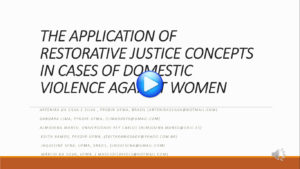 Title: THE APPLICATION OF RESTORATIVE JUSTICE CONCEPTS IN CASES OF DOMESTIC VIOLENCE AGAINST WOMEN
Title: THE APPLICATION OF RESTORATIVE JUSTICE CONCEPTS IN CASES OF DOMESTIC VIOLENCE AGAINST WOMEN
Submission code: VP_252
Authors: Artenira da Silva e Silva, Dandara Lima, Almudena García-Manso, Edith Ramos, Jaqueline Sena, & Márcio da Silva
Abstract: Restorative justice serves the purpose of regarding the various relations affected between the different actors in a criminal context, identifying their needs and seeking ways to repair their possible still remaining relationships in any possible way. Domestic violence has the peculiarity of involving complex affective and emotional bounds between the victims and the aggressors and therefore it is clearly underserved when managed by merely punitive bias of justice. Considering this context, the present study aims to stablish possible links between the paradigm of restorative justice and its application in cases of domestic violence against women. Through bibliographic and documentary research techniques, it was stablished that restorative justice concepts can be used with success in order to serve the purpose of empowering the victim as well as it can help the offender reflect upon his concepts of masculinity and the traits of abusive gender relationships victimizing women. Therefore, restorative justice approach might highlight positive results that can enable victims and offenders to develop some amount of awareness and transformation considering the emotional bounds they share, as well as considering that these fronts of actions are essential to discontinue and or to prevent the cycle of domestic violence. The increasing and gradual institutionalization of restorative justice in the world and in Brazil was equally observed, evidencing the legal possibility of its application in cases of domestic violence in the country. In the other hand, the limitations and possibilities of applying restorative justice in this type of violence were evidenced, opposing the favorable arguments and the relevant criticisms towards the usage of restorative justice concepts in cases of domestic violence against women. This paper also highlights some Brazilian initiatives already executed in this considered field of study. The results reveal the need of further discussions, exchange of experiences and new researches, in order to stablish a minimum consensus on the subject, taking into account the complexity and specificities of domestic violence against women, focusing on the urgent need to find better ways to actually prevent and combat domestic violence against women.
Keywords: Restorative justice, domestic violence, victim, aggressor.
File Extension: MP4 (.mp4)
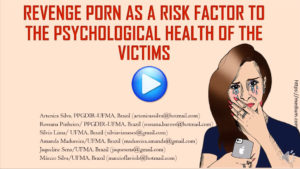 Title: REVENGE PORN AS A RISK FACTOR TO THE PSYCHOLOGICAL HEALTH OF THE VICTIMS
Title: REVENGE PORN AS A RISK FACTOR TO THE PSYCHOLOGICAL HEALTH OF THE VICTIMS
Submission code: VP_253
Authors: Artenira Silva, Rossana Pinheiro, Sílvia Lima, Amanda Madureira, Jaqueline Sena, & Márcio da Silva
Abstract: The revenge porn is the illegal, unauthorized and deliberate exposure of female sexuality in presential or virtual spaces, which happens mainly as a form of revenge in the end of emotional relationships. This crime is a form of gender violence because it is based on the cultural differentiation between masculine and feminine social functions, naturalized in the behaviors of aggressors, victims and the society in general, including the professionals who work in the legal systems. In this context, the social judgment of victims end up encouraging the violence perpetrated by the criminal behavior here described, resulting in cyberbullying, job loss, address changes, suicidal thoughts, suicidal attempts and actual suicides. Suffering with the collapse of their personal and professional life, the victims of revenge porn undergo intense suffering and have their psychological health affected. This condition of physical and mental compromise caused by psychological violence is studied in the medical field as a cause of various symptoms and diseases such as depression, headaches, stomach pains, anxiety, sleep disorders, lack of appetite, for example. In cases of revenge porn, these psychosomatic symptoms and the emergence of various other physical symptoms aggravate suicidal thoughts reported by the totality of the victims of these crimes. Suffering with irreversible injuries caused by psychological and moral violence before and after the so called intimate exposure, victims of revenge porn often progress towards suicidal attempts because of the increasing effects of cyberbullying and because of the moral judgment they have to face even in the justice system, what can be characterized by the practice of institutional violence. In this context, the present study explored the links between revenge porn and psychological violence, explaining how the victims of this crime suffer from the loss of their psychological health and with the emergence of physiological and emotional illnesses that can actually lead them to suicide. In this discussion, the study here presented also points out how the perpetrators play an important role in motivating the victims to commit suicide. In order to achieve these objectives, the following research proceedings were adopted: field research, documentary research, bibliographic research, normative research and content analysis of the documentary and the normative research carried out in order to process the results obtained.
Keywords: Revenge porn, gender violence, suicide, psychological violence.
File Extension: MP4 (.mp4)
Cognitive and Experimental Psychology:
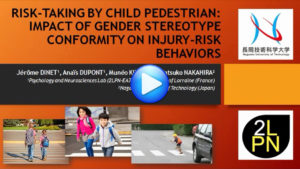 Title: RISK-TAKING BY CHILD PEDESTRIAN: IMPACT OF GENDER STEREOTYPE CONFORMITY ON INJURY-RISK BEHAVIORS
Title: RISK-TAKING BY CHILD PEDESTRIAN: IMPACT OF GENDER STEREOTYPE CONFORMITY ON INJURY-RISK BEHAVIORS
Submission code: VP_109
Authors: Jérôme Dinet, Anaïs Dupont, Munéo Kitajima, & Katsuko Nakahira
Abstract: Child pedestrian injuries – resulting from collisions between child-pedestrians and motor-vehicles – are a leading cause of injury related deaths for children aged 10 years and under. With an experiment conducted with a large sample of children (N=197) and based on the “GO/NO GO” task, we investigate the impact of three individual factors (age, biological gender, gender role behavior) on decision-making for young children aged from 3 to 10 years in tasks related to pedestrian activity. Results show that the gender role behavior (Masculine vs. Feminine) has a significant impact on response time to make decision, while the biological gender (boy vs. girl) has no impact. In other words, boys’ and girls’ injury-risk behaviors are mainly predicted by masculine stereotype conformity and girls’ masculine behaviors decline with increasing age. Moreover, results show that the younger the child is, the more risky s/he is. In other words, results underline the impact of gender-roles – and of the differential socialization associated with those roles – on sex differences in young pedestrian’s risky behaviors as early as the preschool period.
Keywords: Risk making, gender, accident, pedestrian.
File Extension: Windows Media Audio/Video file (.wmv)
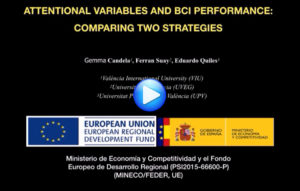 Title: ATTENTIONAL VARIABLES AND BCI PERFORMANCE: COMPARING TWO STRATEGIES
Title: ATTENTIONAL VARIABLES AND BCI PERFORMANCE: COMPARING TWO STRATEGIES
Submission code: VP_225
Authors: Gemma Candela, Ferran Suay, & Eduardo Quiles
Abstract: In order to study which attentional variables could be useful to identify fast- and slow-learners of the Brain-Computer Interface (BCI) tasks, 91 students (75 female and 16 male; Age: 19.46 ± 4.94) completed a standard attentional test (CPT-II) as well as a Virtual-reality Test (Nesplora) and took part in two sessions of a motor-imagery task (cursor-task) by means of Enobio 8 and BCI 2000. In the first one they were instructed to thinking about relaxing their arms when they wanted the cursor to go down and about straining the arms when they wanted to direct the cursor upwards (Action/Relaxation Instruction: ARI). In the second session, the instructions were to think about raising their arms to bring the cursor upwards and pressing-down with their feet (as if pressing a car’s brake pedal) if they wanted to bring it downwards (Action/Action Instruction: AAI). In both sessions, any actual movement or muscular tension was precluded and only the second strategy was effective (p=.00) to increase BCI-related performance.
Our results with the Nesplora test show positive correlations between the variable Learning and (a) Reaction-Time in Mistakes (r= .654; p=.019); (b) average Reaction-Time to the hyper-stimulation task (r=.705; p= 0.014), and (c) Average Reaction-Time in Mistakes when no distractors were present (r=.692; p=0.051). For the CPT-II test Learning positive correlations were found with HRTISIC (Hit Reaction Time ISI Change) (r= .450; p=.046) and Detectability (r=.948; p= 0.008).
We conclude that (1) The AAI strategy is more useful than the ARI to learn the cursor-task through BCI; (2) The attentional variables that may affect the process of learning BCI tasks are processing speed, cognitive flexibility and the ability to control impulsivity.
Keywords: Brain computer interface, learning, instructions, attention, BCI 2000.
File Extension: Windows Media Audio/Video file (.wmv)
 Title: SPEECH DISORDERS IN ALZHEIMER’S DISEASE: PRECLINICAL MARKERS OF DEMENTIA?
Title: SPEECH DISORDERS IN ALZHEIMER’S DISEASE: PRECLINICAL MARKERS OF DEMENTIA?
Submission code: VP_249
Authors: Olga Ivanova, Juan José García Meilán, Francisco Martínez-Sánchez, & Juan Carro
Abstract: As has been shown in research, speech and language impairments are one of the key clinical manifestations of early-stage Alzheimer’s Disease (AD). Currently, speech and language disorders are considered as important as other cognitive disruptions (memory loss, executive disfunction, learning problems or vision impairments) for early detection of AD and its discrimination from other age-related pathologies, like amnesic Mild Cognitive Impairment, depressive and mood disorders. Traditionally, AD language symptoms have been linked to difficulties in accessing lexicon and semantic networks. More recent studies, however, have emphasized that speech level impairs formerly in AD and therefore may have greater value in early diagnosis of this neurodegeneration. The aim of this work is to offer an overview of speech variables, which undergo significant changes under neurodegenerative processes of AD, and to attest how their assessment may allow detecting AD onset at preclinical stages of dementia. To that end, we draw upon the results from our speech analysis experiments with healthy elderly, persons with aMCI and AD sufferers, and discuss the potential predictivity of different temporal, acoustic and prosodic variables of vocal emission.
Keywords: Alzheimer’s disease, speech, voice impairments, early diagnosis, automatic speech analysis.
File Extension: QuickTime Movie (.mov)
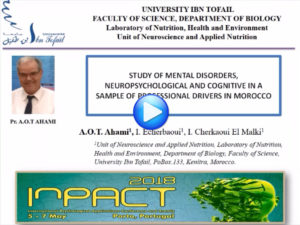 Title: STUDY OF MENTAL DISORDERS, NEUROPSYCHOLOGICAL AND COGNITIVE AMONG A SAMPLE OF PROFESSIONAL DRIVERS IN MOROCCO
Title: STUDY OF MENTAL DISORDERS, NEUROPSYCHOLOGICAL AND COGNITIVE AMONG A SAMPLE OF PROFESSIONAL DRIVERS IN MOROCCO
Submission code: VP_286
Authors: Ahmed O. T. Ahami, Imad Echerbaoui, & Ibtissam Cherkaoui El Malki
Abstract: Road accidents are a major public health problem in Morocco. These accidents have a very heavy cost, both human in terms of the number of deaths caused, and social as to the degradation of the mental health of drivers. This work moving towards highlighting the depressive and mental disorders profiles of drivers, with their different characteristics, and searching for associated factors, especially the risk of road accidents. The study is a descriptive transversal type, carried out with 60 non-professional drivers and 60 drivers of small taxis in Kenitra, Morocco. The study conducted using a questionnaire and the test Mini International Neuropsychiatric Interview (MINI). The results indicate that drivers work 8 to 12 hours per day and 65% of them take a break after 5 to 6 hours of work. In addition, 16.67% of drivers have a severe depressive profile compared to 6.67% of non-professional drivers. Likewise, clinical analyzes have shown mnemonic and perceptual changes and attention disorders in professional drivers. A strong correlation (p <0.001) is found between this depressive profile and the rate of road accidents (approximately 33% of PD have a single accident versus 18% of NPD respectively). These results highlight the importance of emergency response for professional drivers to reduce or eliminate accidents and promote mental health at work.
Keywords: Accident, public health, depressive profile, professional drivers, Morocco.
File Extension: MP4 (.mp4)
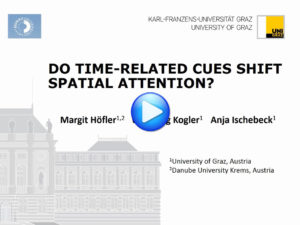 Title: DO TIME-RELATED CUES SHIFT SPATIAL ATTENTION?
Title: DO TIME-RELATED CUES SHIFT SPATIAL ATTENTION?
Submission code: VP_296
Authors: Margit Höfler, Wolfgang Kogler, Anja Ischebeck
Abstract: When a cue such as an arrow is presented at the center of a screen, participants typically respond faster to a subsequently presented target that is presented in the direction of that cue. This attentional shift has also been demonstrated for semantic cues such as pictures or words that refer to a spatial direction (e.g., the word “sky” has been shown to shift attention upwards). Here we investigated whether time-related words are also able to trigger attentional shifts. There is evidence that we represent temporal relationships on a mental left-to-right line such that events in the past are represented more left on this line whereas events in the future are represented on the right. We presented words as cues that either referred to the past (“yesterday“, “previously”), the future (“tomorrow”, “subsequently”) or the presence (“today”, “now”) as the neutral condition at the center of a screen and had participants respond to a target presented after 150, 300, or 1250 ms either to the left or to the right side of the cue. We expected faster response times for congruent cue-target combinations (e.g., “tomorrow” and a target on the right side) compared to incongruent cue-target combinations (e.g., “yesterday”, target right) for the 150 ms delay. For the longer delays, we expected the opposite effect, because of inhibition of return. However, the results revealed that the congruency of the cue type had no effect on the manual response times to the target. This suggests that time-related cues do not trigger shifts of spatial attention. Our results therefore shed some doubt on the assumed left-to-right association of time-related words.
Keywords: Spatial attention, time-related cues, attentional shift, cueing paradigm.
File Extension: Windows Media Audio/Video file (.wmv)

